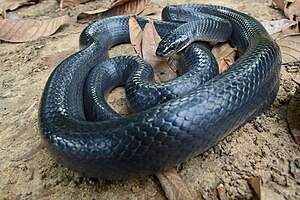Mussurana
| Mussurana | ||||||||||||
|---|---|---|---|---|---|---|---|---|---|---|---|---|

Mussurana ( Clelia clelia ) |
||||||||||||
| Systematics | ||||||||||||
|
||||||||||||
| Scientific name | ||||||||||||
| Clelia clelia | ||||||||||||
| ( Daudin , 1803) |
The Mussurana ( Clelia clelia ) is a species of snake native to Central and South America. It belongs within the family of the adder (Colubridae) to the genus of the Mussuranas ( Clelia ). In Spanish, the Mussurana is called culebra minadora or lisa .
features
The Mussurana reaches a body length of about 1.50 to 1.60 meters, but it can be up to 2.40 meters long.
There are 194-218 ventral scales in the female and 193-213 in the males. After the anal shield there are 62–74 subcaudals in females and 75–88 in males . Clelia clelia usually has seven shields of the upper lip , of which the second and third, counting from the front, adjoin the relatively large Loreale .
The back of the young snakes is pink or reddish in color. This color changes to a blue color with increasing age; in adulthood, the back has a lead-colored tint. A black spot appears in the front of the back. Furthermore you can see a white and a black neck band. The head of the young snakes is usually tinted black. The belly is usually covered with some black pigmentation. The chin area and the lower tail area are colored white. In adults, the abdomen has a yellowish tinge. In contrast to the very similar looking Boiruna maculata , the belly is never completely dark in color. In Clelia plumbea , a similarly colored and equally large species of the genus Clelia , the dividing line between light belly and dark back color is straight, while in Clelia clelia it is toothed.
The Mussurana has 10 to 15 strong teeth in the back of the upper jaw ( proteroglyph ), which it uses to grasp the head of the attacked prey. The body and tail are then wrapped around the victim.
Subspecies
The following three subspecies are distinguished:
- Clelia clelia clelia ( Daudin , 1803)
- Clelia clelia groomei Greer , 1965
- Clelia clelia immaculata Smith , 1942
In particular, the subspecies status of Clelia clelia immaculata is controversial.
distribution
The Mussurana occurs in almost all Central and South American countries.
Way of life
The Mussurana prefers habitats with dense vegetation. It is a diurnal, ground-dwelling snake that is sometimes active at night. Although it has poison fangs , there is no danger to humans because the poison is weak. Very few cases of poisoning have been reported; these were also not fatal.
nutrition
The Mussurana is immune to the venom of other snakes on which it feeds, especially American lance vipers ( Bothrops ), the subfamily of the pit vipers (Crotalinae). However, the mussurana is not immune to the venom of the coral otters ( Micrurus ). Furthermore, the Mussurana eaten also crawl and lizards, ameivas and Tejus . If there aren't enough other snakes, it can also feed on small mammals, as well as earthworms, snails, and land snails. The Mussurana has 10 to 15 strong teeth in the back of the upper jaw (proteroglyph), which it uses to grasp the head of the attacked snake. Then the mussurana winds its tail and body around the victim. This is the reason why the species is also called Pseudoboa.
Reproduction
The Mussurana is one of the egg-laying species. The mating season usually begins shortly after hibernation. In one season there is only one oviposition. Shortly after successful mating, the female lays the eggs in a sheltered place in a shallow earth hollow. Depending on the ambient temperature, the young snakes hatch after 50 to 80 days. They are already 30 to 35 centimeters long and immediately left to their own devices. Brood care by the female is not carried out. The young snakes initially feed mainly on insects, small lizards and other small animals.
Hazard and protection
In most of the distribution areas, the Mussurana is still quite common. The still healthy populations cannot hide the fact that large parts of the natural habitats are threatened by urbanization and drainage. The Mussurana controls the populations mainly of earthworms and snails in the habitats . Some farmers even keep mussuranas as pets to better protect their cattle from pit vipers.
literature
- Roland Bauchot: Snakes. Weltbild Verlag, 1999, ISBN 3-8289-1501-9 .
- Dieter Schmidt: Adders fascinating & exotic. 1st edition. Gräfe & Unzer, February 2005, ISBN 3774269475 .
Web links
- Clelia clelia in The Reptile Database
- More pictures on Flickr.com
- Pit viper is eaten by a mussurana (video)
Individual evidence
- ^ A b Norman J. Scott Jr, Alejandro R. Giraudo, Gustavo Scrocchi, Aida Luz Aquino, Pier Cacciali, Martha Motte: The Genera Boiruna and Clelia (Serpentes: Pseudoboini) in Paraguay and Argentina . tape 46 , no. 9 , 2006, p. 77-105 .
- ^ A b Clelia clelia in The Reptile Database
